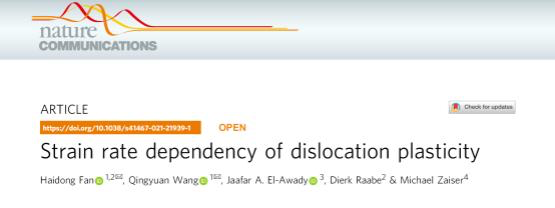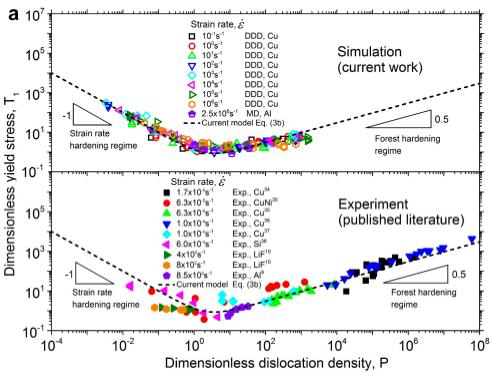In collaboration with Prof. Qingyuan Wang, Prof. El-Awady of the Johns Hopkins University, Prof. Raabe ofMax-Planck-Institut für Eisenforschung GmbH, Düsseldorf, Germanyand Prof. Zaiser of theUniversity of Erlangen-Nuremberg, Prof. Haidong Fan of the Department of Mechanics, Sichuan University, published the latest research achievement "Strain Rate Dependency of Dislocation Plasticity" in Nature Communications. SCU is the first work unit. Haidong Fan is the first author and Qingyuan Wang and Haidong Fan are co corresponding authors. This work was supported by National Natural Science Foundation of China (12072211, U1730106), Sichuan Province Science and Technology Project (2020JDJQ0029), Alexander von Humboldt Foundation, Chinese State Administration of Foreign Experts Affairs #MS2016XNJT044 and US National Science Foundation Award #DMR-1609533.

Employing the big data research method, the research team carried out 194 dislocation dynamics simulations, with dislocation density spanning 9 orders of magnitude and strain rate spanning 10 orders of magnitude. “Dislocation glide is a general deformation mode, governing the strength of metals. Via discrete dislocation dynamics and molecular dynamics simulations, we investigate the strain rate and dislocation density dependence of the strength of bulk copper and aluminum single crystals. An analytical relationship between material strength, dislocation density, strain rate and dislocation mobility is proposed, which agrees well with current simulations and published experiments. Results show that material strength displays a decreasing regime (strain rate hardening) and then increasing regime (classical forest hardening) as the dislocation density increases. Accordingly, the strength displays universally, as the strain rate increases, a strain rate-independent regime followed by a strain rate hardening regime. All results are captured by a single scaling function, which relates the scaled strength to a coupling parameter between dislocation density and strain rate. Such coupling parameter also controls the localization of plasticity, fluctuations of dislocation flow and distribution of dislocation velocity.”(Abstract)


Prof. Fan is a candidate of the national talent program, German "Humboldt scholar" and Sichuan University "Double Hundred Talent Project" A program. His research is mainly focused on plastic mechanism and radiation effect of metal materials. In recent years, he has directed 4 NSFC projects and published more than 60 papers in Journal of Mechanics and Physics of Solids (JMPS), International Journal of Plastics (IJP), Acta Materialia and so forth. His achievements have been acclaimed by peers at home and abroad as seminal, pioneering and the most important in the field by far.
Article link:https://www.nature.com/articles/s41467-021-21939-1
